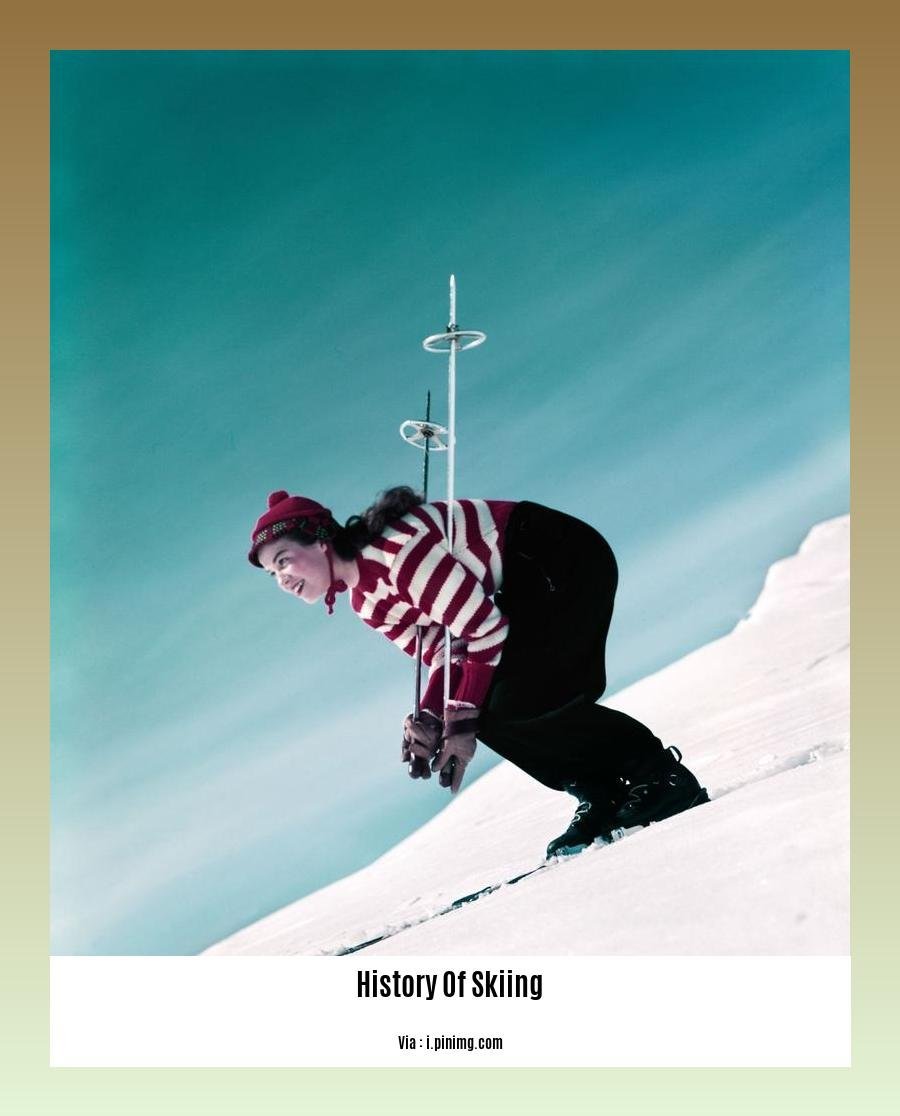Prepare to embark on an epic journey through the annals of winter sports with our comprehensive history of skiing: “A Comprehensive History of Skiing: From Ancient Origins to Modern Thrills.” Our exploration delves into the intriguing origins of skiing, uncovering its humble beginnings and tracing its evolution into the thrilling pastime we know and love today. Along the way, we’ll unveil captivating tales of the pioneers who shaped this captivating sport and unravel the cultural significance of skiing throughout history.
Key Takeaways:
- Skiing dates back to at least 6000 BCE, with archaeological evidence from Karelia.
- The term “ski” comes from the Old Norse word “skíð,” meaning “cleft wood.”
- Early skiing served practical purposes, such as hunting and military exercises.
- Asymmetrical skis were once common in Finland and Sweden.
- Skiing emerged as a recreational activity in the 19th century.
History of Skiing

The history of skiing stretches back a remarkable 6 millennia, its humble origins rooted in the icy terrains of Karelia. Derived from Old Norse, the term “ski” translates to “cleft wood” or “stick of wood.” These early skis, crafted from animal bones and wood, were rudimentary yet functional tools primarily used for hunting, mirroring the legendary feats of Norse gods and goddesses gliding through wintery landscapes.
Over time, skiing found its place in the realm of warfare, becoming an integral part of Norwegian and Swedish military training, allowing for swift and covert maneuvers on snow-covered battlefields. Gradually, the allure of skiing’s speed and agility transcended military applications, blossoming into a recreational pursuit that captured the hearts of many.
The 19th century marked a pivotal moment in the history of skiing, as it transitioned from a utilitarian tool to a beloved pastime. The introduction of symmetrical skis and bindings enhanced stability and control, paving the way for organized skiing exercises and races. The advent of ski resorts and the growing popularity of winter tourism further propelled skiing’s rise to prominence.
As skiing captivated the imaginations of enthusiasts worldwide, innovations continued to push the boundaries. The invention of the steel edge in the early 20th century revolutionized ski design, enabling skiers to carve turns with precision and confidence. Technological advancements such as synthetic materials, fiberglass, and composite skis further enhanced performance and accessibility.
Today, the history of skiing is a rich tapestry woven with stories of pioneers, technological breakthroughs, and the enduring spirit of adventure. It’s a legacy that continues to inspire skiers of all ages to embrace the exhilaration of gliding across snow-covered landscapes, leaving an indelible mark on winter sports and the annals of human history.
Skiing has an interesting history which you can discover in our ski history timeline. Learn more about the evolution of skiing. Skiing has a long and fascinating history, dating back to the skiing origin in prehistoric times. Over the centuries, skiing has evolved from a practical mode of transportation to a popular recreational activity. The skiing evolution has been marked by a number of technological innovations, including the development of metal skis and plastic boots.
History of Skiing Facts

Skiing, an exhilarating pastime enjoyed by countless enthusiasts worldwide, boasts a rich and captivating history. Let’s delve into some fascinating history of skiing facts:
Origins in Scandinavia
The roots of skiing can be traced back to around 3500 BCE in Scandinavia. Cave drawings and archaeological discoveries reveal the use of skis by hunters and travelers, primarily for utilitarian purposes.
Military Roots
Skiing played a vital role in military operations. Armed forces in Norway and Sweden utilized skis for transportation and combat maneuvers, facilitating mobility in snowy terrains.
From Utility to Recreation
The 18th century marked a shift towards skiing for recreational purposes. The Norwegian people developed it into a sport, with the first recorded ski jump in 1809.
Alpine Skiing’s Emergence
The early 19th century saw the rise of alpine skiing, which focused on downhill runs. This style gained popularity, leading to the development of specialized equipment.
Organized Competitions
Skiing’s competitive spirit manifested in the inaugural cross-country national races held in Oslo, Norway, in 1867. Organized events and competitions spurred innovation and fueled the sport’s growth.
Technological Advancements
Skiing underwent significant advancements in the 20th century. The introduction of ski lifts in the early 1900s revolutionized the sport, making it more accessible and enjoyable for a wider audience.
Modern Skiing
Today, skiing has evolved into a global phenomenon, with countless variations and disciplines. From downhill racing to freestyle jumps, the sport continues to captivate and inspire.
Key Takeaways:
- Skiing’s origins can be traced back to Scandinavia around 3500 BCE.
- Initially used for hunting and transportation, skiing evolved into a recreational sport in Norway during the 18th century.
- Alpine skiing emerged as a popular style in the early 19th century.
- Organized competitions and national races were held in Norway from 1867 onwards.
- Advancements such as the ski lift made skiing more accessible to the masses.
- Today, skiing is a globally recognized sport with numerous variations and disciplines.
Citation:
“History of Skiing.” Wikipedia, the Free Encyclopedia. Wikipedia, the Free Encyclopedia, [Date of Access]. Web.
History of Skiing in Switzerland
The Swiss Alps, well-known for their spectacular beauty, have also been the setting for a long and illustrious history of skiing in Switzerland. Here’s an exploration of its fascinating evolution:
Key Takeaways:
- Skiing arrived in Switzerland around 1890, initially used for practical purposes.
- The first skiing club was founded in Glarus in 1893.
- Switzerland has been at the forefront of skiing advancements and hosted numerous international competitions.
Norwegian Roots and Early Adoption
Skiing was introduced to Switzerland by Norwegian individuals in the late 19th century. Initially used for mountain expeditions, it quickly gained traction as a recreational activity.
The Rise of Skiing Clubs and Competitions
The establishment of the first skiing club in Glarus in 1893 marked a significant milestone. This paved the way for organized skiing activities and the initiation of ski races in 1902.
International Acclaim and Swiss Dominance
Switzerland made its mark on the international skiing scene with the founding of the Swiss Ski Association (SSV) in 1904. The country has played a pivotal role in the development of skiing techniques and equipment and has hosted prestigious competitions, including the FIS Alpine World Ski Championships.
Citation:
- Swiss History – The little country that’s a big skiing nation
FAQ
Q1: When was skiing first invented?
A1: The earliest evidence of skiing dates back to at least 6000 BCE, with archaeological findings in Karelia.
Q2: Where did skiing originate?
A2: Skiing originated in Scandinavia, with the earliest known skiers being the Sami people.
Q3: How did skiing evolve from a utilitarian activity to a recreational sport?
A3: Skiing initially served practical purposes, such as hunting and transportation. It gradually evolved into a recreational activity in the 19th century, influenced by factors like organized military exercises and the establishment of skiing clubs.
Q4: Who is credited with the first known ski jump?
A4: Olaf Rye performed the first known ski jump in 1809.
Q5: When did skiing become popular in Switzerland?
A5: Skiing was introduced to Switzerland around 1890 and gained popularity as a recreational activity, leading to the establishment of skiing clubs and the inauguration of ski races in the early 1900s.
- Unlocking Francis Alexander Shields’ Finance Empire: A Comprehensive Biography - July 12, 2025
- Unveiling Francis Alexander Shields: A Business Legacy - July 12, 2025
- Francis Alexander Shields’ Business Career: A Comprehensive Overview - July 12, 2025















